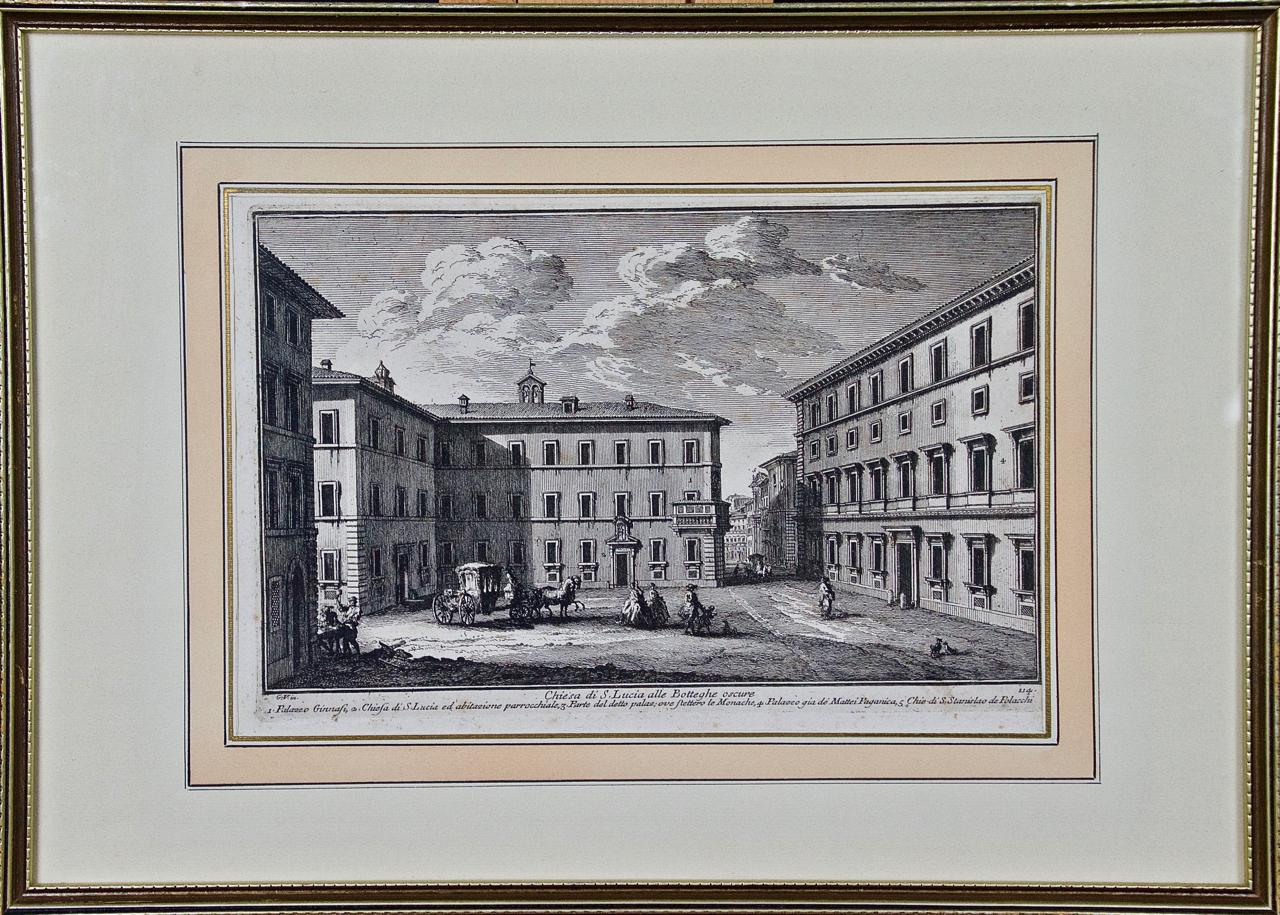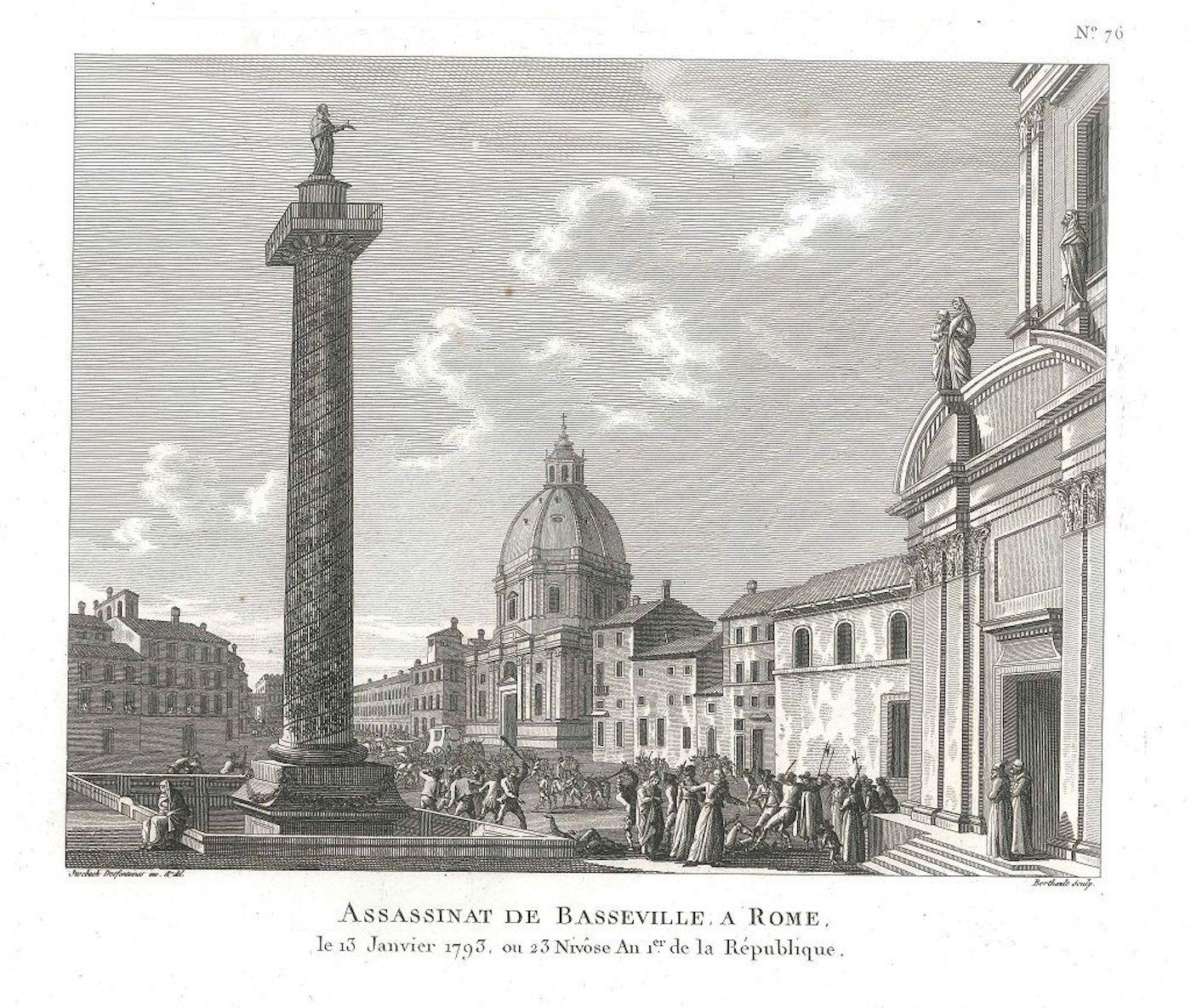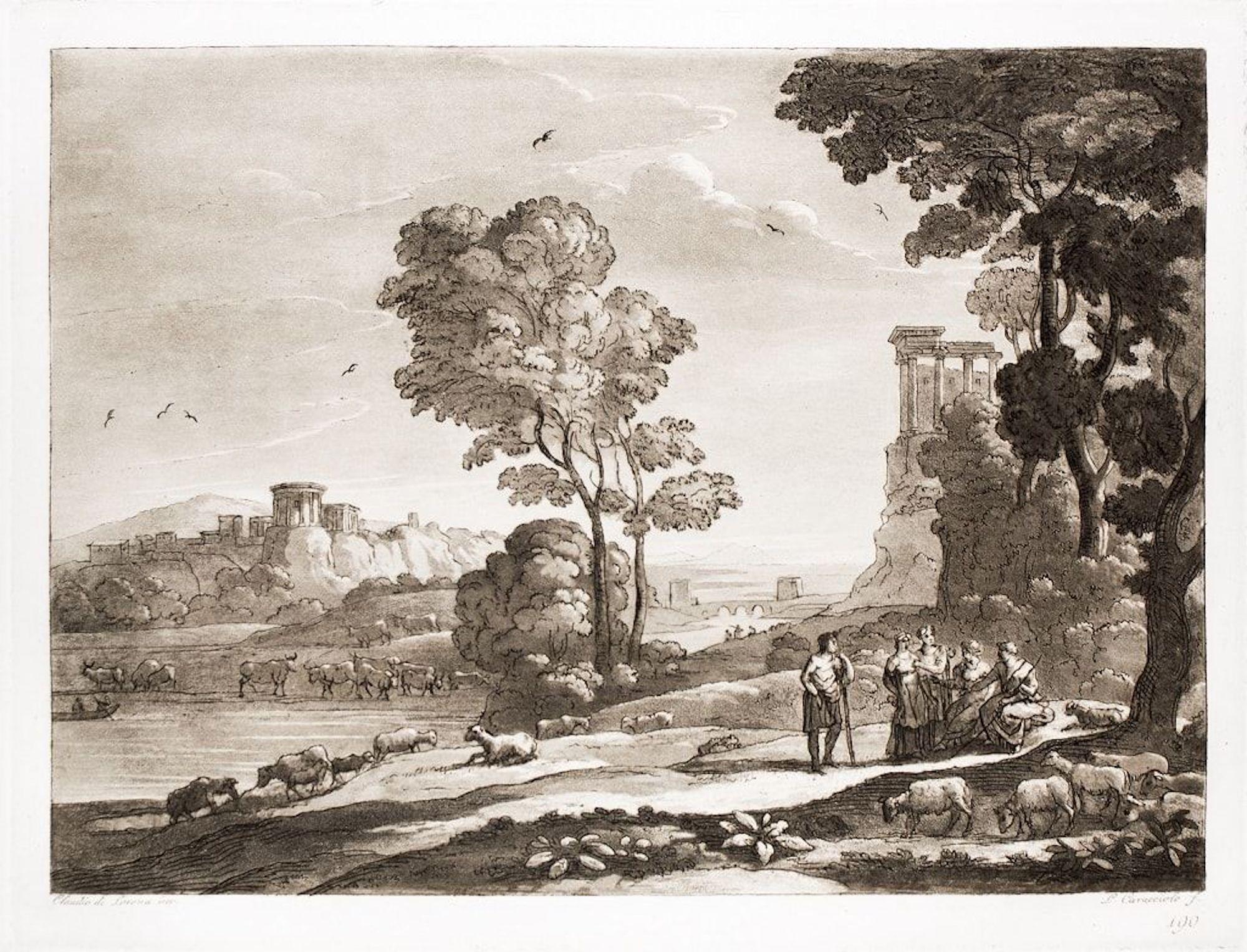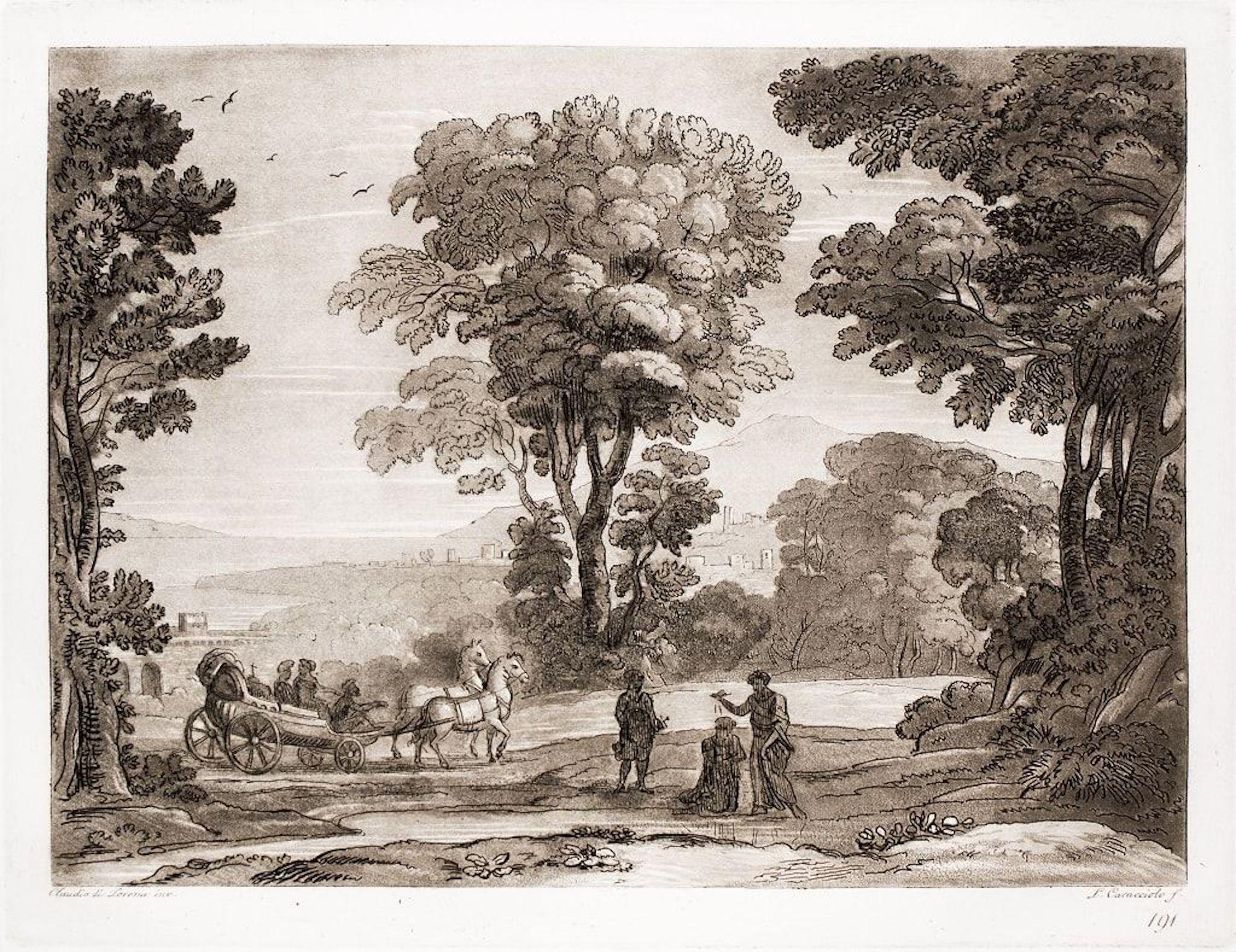Items Similar to Piranesi 18th C. Etching "Reliquiae Theartri Pompejani" an Ancient Roman Theater
Want more images or videos?
Request additional images or videos from the seller
1 of 9
Giovanni Battista PiranesiPiranesi 18th C. Etching "Reliquiae Theartri Pompejani" an Ancient Roman Theater1762
1762
About the Item
This a framed Giovanni Battista Piranesi (1720-1778) etching entitled "Reliquiae Theartri Pompejani" (Remains of the Theatre of Pompey) from "Il Campo Marzio dell'Antica Roma" (The Campus Martius of Ancient Rome), published in Rome in 1762. It depicts the remains of an ancient theater in Rome with exposed seating and an arch still standing in the foreground. An inset shows an architectural side view of a portion of the structure.
The etching is presented in an antiqued silver-colored wood frame with a cream-colored French mat. The frame measures 24" x 20.75" x 1.25". The print is in excellent condition.
The Theatre of Pompey (Latin: Theatrum Pompeii, Italian: Teatro di Pompeo) was a structure in Ancient Rome built during the latter part of the Roman Republican era by Pompey the Great (Gnaeus Pompeius Magnus). Completed in 55 BC, it was the first permanent theater to be built in Rome. The theater was inspired by Pompey's visit in 62 BC to a Greek theatre in Mytilene.
Giovanni Battista Piranesi (1720–1778) was born in Venice in 1720 and died in Rome in 1778. He was the son of a stone mason and was trained as an architect. After a slow start to his career, he eventually achieved great success as an architect, archaeologist, artist, designer, collector, and antiquities dealer. His mission was to glorify the architecture of ancient Rome through his etchings. He began collecting, restoring and selling ancient architectural objects in the 1760's in partnership with Thomas Jenkins and Gavin Hamilton, who had financed numerous excavations in the Pantanello area of Hadrian’s Villa at Tivoli. In 1768 Piranesi began creating etchings depicting these objects. The plates were eventually published together as a set in 1778 in "Vasi, Candelabri, Cippi, Sarcofagi, Tripodi, Lucerne ed Ornamenti Antichi". Piranesi dedicated many of the plates to patrons, colleagues, good customers and influential people. Many of the antiquities shown in Vasi were eventually sold to King Gustav III of Sweden by Piranesi's son, Francesco Piranesi, after his father’s death, and now reside in the National Museum in Stockholm.
Piranesi's etchings were highly detailed and captured the grandeur of Rome's ancient ruins and architectural marvels. He used a combination of realism and imagination to create dramatic compositions that were both accurate and awe-inspiring. His highly dramatized prints often depict imaginary interiors and frequently include figures in mysterious activities, who are dwarfed by the magnitude of their monumental surroundings.
In addition to his art, Piranesi also designed buildings and interiors in Rome, including the Church of Santa Maria del Priorato and the Villa Adriana in Tivoli. He also wrote several books on archaeology and ancient art. He was also a collector of ancient architectural objects, restoring and often selling them to European tourists. Piranesi was knighted by the Pope in 1765 and he was elected a Fellow of the Society of Antiquaries in England in 1757. Piranesi's style greatly influenced the development of neoclassical art movement of the late 18th century and early 19th centuries. His dramatic scenes inspired generations of set designers, as well as artists, architects and writers. Piranesi died on November 9, 1778, in Rome, Italy, at the age of 58. He is remembered today as one of the greatest artists and architects of the 18th century, whose work continues to inspire and fascinate people around the world. His prints have continued to increase in value to institutions and collectors.
- Creator:Giovanni Battista Piranesi (1720-1778, Italian)
- Creation Year:1762
- Dimensions:Height: 24 in (60.96 cm)Width: 20.75 in (52.71 cm)Depth: 1.25 in (3.18 cm)
- Medium:
- Movement & Style:
- Period:
- Condition:
- Gallery Location:Alamo, CA
- Reference Number:
Giovanni Battista Piranesi
Piranesi was born in Venice in 1720 and died in Rome in 1778. He was the son of a stone mason and was trained as an architect. After a slow start he eventually achieved great success as an architect, archaeologist, artist, designer, collector, and antiquities dealer. His mission was to glorify the architecture of ancient Rome through his engravings and etchings. His highly dramatized prints often depict imaginary interiors and frequently include figures in mysterious activities, who are dwarfed by the magnitude of their monumental surroundings. Piranesi's style greatly influenced the neoclassical art movement of the late 18th century. His dramatic scenes inspired generations of set designers, as well as artists, architects and writers. His prints have continued to increase in value to institutions and collectors.
About the Seller
5.0
Vetted Seller
These experienced sellers undergo a comprehensive evaluation by our team of in-house experts.
Established in 2011
1stDibs seller since 2019
239 sales on 1stDibs
Typical response time: 1 hour
- ShippingRetrieving quote...Ships From: Alamo, CA
- Return PolicyA return for this item may be initiated within 7 days of delivery.
More From This SellerView All
- 18th Century Etching of "Chiesa di S. Lucia" in Rome by Giuseppe VasiBy Giuseppe VasiLocated in Alamo, CAThis 18th century etching is entitled "Chiesa di S. Lucia alle Botteghe Oscure" by Giuseppe Vasi was published in Rome in 1747 in Vasi's 'Magnificenze di Roma Antica e Moderna', whic...Category
Mid-18th Century Old Masters Landscape Prints
MaterialsEtching
- Piranesi Etching of Hadrian's Ancient Roman Aqueduct and Baths, "Aquae Virginis"By Giovanni Battista PiranesiLocated in Alamo, CAThis is a framed Giovanni Battista Piranesi (1720-1778) etching entitled "Orthographia utriusque lateris arcuum ductus Aquae Virginis a specu principe ad Hadriani thermas, effossorum...Category
Mid-18th Century Old Masters Landscape Prints
MaterialsEtching
- Giovanni Piranesi Etching of Ancient Roman Architecture, 18th CenturyBy Giovanni Battista PiranesiLocated in Alamo, CA"Veduta del Sepolcro della Famiglia Plauzia per la Strada Che Conduce da Roma a Tivoli vicino a Ponte Lugano" from "Le Antichità Romane" (Roman Antiquities), one of the most famous works by Piranesi. "Antichita" illustrates the tombs along the Appian Way...Category
Early 18th Century Old Masters Figurative Prints
MaterialsDrypoint, Engraving, Etching
- Daniel Marot's The Siege of the Dutch Fortified City of Ypres by Louis XIVBy Daniel MarotLocated in Alamo, CA"Ypres, Grand Ville Riche & Marchande" is an engraving and etching by Daniel Marot (le Vieux) (1661–1752). It depicts a view of the siege of the city of Ypres and its citadel on the left in the Spanish Netherlands by Louis XIV's troops. This battle took place between March 18 and March 25, 1678, as part of the Franco-Dutch War. Marot illustrated in great detail (best appreciated with magnification) the French attack on the strong pentagonal citadel on the extreme left, which had been built recently in anticipation of a French attack. The trenches built by the French approaching the town are seen on the right. King Louis XIV can be seen in the foreground surveying the battle mounted on his white horse, surrounded by his officers and troops. The print is presented in an attractive ornate black wood frame with a cream-colored double mat with a black inner trim. It is glazed with plexiglas. The frame measures 25.38" x 22.63" x .88". The engraving, frame, mat and glazing are in excellent condition. Artist: Daniel Marot (1661–1752) was also called "Le Vieux". He was the son of the famous architect, Jean Marot. Marot had diverse interests and talents. In addition to his art, he designed garden projects, architectural ornaments, furniture, and even upholstery. Marot as a Huguenot protestant was forced to leave France in 1685 following the revocation of the Edict of Nantes. He emigrated to Holland, where he worked for William of Orange (an arch enemy of his former employer Louis XIV). Marot was largely responsible for the interiors of Williams palace at the Loo. In 1694 he went Britain as William had married Queen Mary and he had become King William III of England. He later returned to Holland in about 1698 and died in the Hague in 1752. He left a lasting legacy on the decorative arts in the Netherlands, where his grand version of the Louis XIV style remained popular into the 1730s. Historical Background: In October 1677, Mary Stuart, niece and possible successor of Charles II of England, married Louis XIV's arch enemy William III of Orange...Category
Late 17th Century Old Masters Landscape Prints
MaterialsEtching, Engraving
- Ancient Roman Temple Architecture: An 18th Century Framed Etching by PiranesiBy Giovanni Battista PiranesiLocated in Alamo, CAThis is an 18th century etching by Giovanni Battista Piranesi entitled "Veduta del Tempio detto della Tosse su la Via Tiburtina, un miglio vicino a Tivoli" (View of the so-called Tem...Category
1760s Old Masters Figurative Prints
MaterialsEtching
- The Basilica of St. Paul in Rome, Early 19th Century Etching by Luigi RossiniBy Luigi RossiniLocated in Alamo, CA"Rovina della gran Basilica di S. Paolo fueri le mura accaduta" (View of the Ruins of the Great Triumphal Arch of S. Paolo Fuori le Mura) from "Le Antichita Romane" (Ancient Rome), published in Rome in 1823. It depicts the destruction of the Basilica of St. Paul after the fire of 1823. People stand in the road and on the right observing the damage amid debris, which includes many fragments of columns. The etching is presented in a silver-color wood frame with an off-white double mat with a black inner mat. There are a few small spots, but it is otherwise in very good condition. See item # LU117324669722 for another Rossini etching...Category
1820s Old Masters Figurative Prints
MaterialsEtching
You May Also Like
- Assassinat de Basseville à Rome - Original Etching by P.G. Berthault - 1793By Pierre Gabriel BerthaultLocated in Roma, ITAssassinat De Basseville à Rome is an original black and white etching realized by Pierre Gabriel Berthault, after Jacques François Joseph Swebach-Desfontaines in 1793. Title with caption on plate on the lower center: "Assassinat de Basseville, à Rome/ le 13 Janvier 1793, ou 23 Nivose An Ier de la République". Below the image on the lower margin, "Swebach Desfontaines onv. et del. / Berthault sculp." is etched on plate. This modern artwork is numbered "N. 76", because it is from the series Les Tableaux historiques de la Révolution française. As a matter of fact, Pierre-Gabriel Berthault is well-known for having engraved plates from this collection with the collaboration of the engraver Jean Duplessis-Bertaux. A work - hanging in the balance between news and history - with illustrations of salient or minimal events occurred during the French Revolution. As a celebration of the new ideals of brotherhood, justice, and equality, Les Tableaux immediately became a point of reference for journalism at the time. Of traditional cut, namely showing a view with many human figures, the engraving simplified the lines to be immediately readable for the general public. In our specific case, this original print represents the murder of Hugou de Bassville or Basseville (7 February, 1743 – 13 January, 1793), a French journalist and diplomatist, and protector of the radical Jacobins in Rome. In excellent conditions, except for a usual yellowing of the paper on the edges and a light trace of oxidations on the lower and right margins, beyond the marginal line of the matrix. Pierre-Gabriel Berthault (Saint-Maur-des-Fossés, 1737 - Paris, 1831) was a French master who made engravings from drawings by Jean-Claude Richard de Saint-Non (known as the Abbot of Saint-Non) and from paintings by Louis François Cassas. He depicted many views of Italy and created the collections Voyage à Naples and Voyage pittoresque de la Syrie, de la Palestine et de la basse-Egypte. Before the French Revolution, he was famous for being the author of the Vues intérieures de Paris and for tables with architectural elevations.Category
1790s Old Masters Landscape Prints
MaterialsEtching
- The Passengers - Original Etching by A. M. de Ghuy - 1775Located in Roma, ITThe Passenger is an original artwork realized by Antoine de Marcenay de Ghuy in 1775. Original etching on paper. Titled on the lower margin at the center. The artwork is glued on ca...Category
1770s Old Masters Landscape Prints
MaterialsEtching
- Liber Veritatis - Original B/W Etching after Claude Lorrain - 1815By Ludovico CaraccioloLocated in Roma, ITImage dimensions: 21 x 27 cm. Liber Veritatis - Plate 190 is a beautiful black and white etching and aquatint on paper realized by the Italian artist Ludovico Caracciolo, after Clau...Category
1810s Old Masters Figurative Prints
MaterialsAquatint, Etching
- Liber Veritatis - Original B/W Etching after Claude Lorrain - 1815By Ludovico CaraccioloLocated in Roma, ITImage dimensions: 21 x 27 cm. Liber Veritatis - Plate 191 is a beautiful black and white etching and aquatint on paper realized by the Italian artist ...Category
1810s Old Masters Figurative Prints
MaterialsAquatint, Etching
- Les Trois Pilons du Carbet / Fort Royal - Original Etching - 19th centuryLocated in Roma, ITLandscape is an original etching on paper realized in 19th Century. Printed in series of "France Pittoresque" at the top center. Titled in France on the lower center. Included two...Category
19th Century Old Masters Landscape Prints
MaterialsEtching
- Landscape fromLiber Veritatis - Original B/W Etching after Claude Lorrain - 1815By Ludovico CaraccioloLocated in Roma, ITImage dimensions: 21 x 27 cm. Liber Veritatis - Plate 162 is a beautiful black and white etching and aquatint on paper realized by the Italian artist Ludovico Caracciolo, after Clau...Category
1810s Old Masters Figurative Prints
MaterialsAquatint, Etching
Recently Viewed
View AllMore Ways To Browse
Ancient Architecture
Ancient Rome
Antique Theater
Antique Roman Figures
18th Century French Landscape
18th C Interior
Architectural Print Set Framed
Old Books Sets
Ancient Roman Antiques
Antique Roman Stone
Antique England Etching
Ancient Church
Ancient Antiques
Roman Bc
Ancient Greek Antiquities
18th C Frame Italian
Antique Etching S
Roman Ruins Framed






